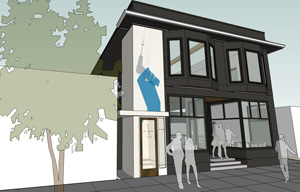Seattle builder Hammer & Hand presents examples of Passive House high performance buildings to the AIA+2030 Professional Series 2012, providing a feasible model for dramatically reducing the energy consumption of Seattle’s residential and commercial buildings.
 Seattle, Washington – Last Friday Seattle builder Hammer & Hand shared high performance building case studies with 60 architects and engineers gathered at Seattle City Hall for the AIA+2030 Professional Series 2012. As a regional and national leader in Passive House (Passivhaus) design and construction, Hammer & Hand was invited by AIA Seattle to present two Passive House case studies: the first residential project in Seattle and the first commercial retrofit in the country.
Seattle, Washington – Last Friday Seattle builder Hammer & Hand shared high performance building case studies with 60 architects and engineers gathered at Seattle City Hall for the AIA+2030 Professional Series 2012. As a regional and national leader in Passive House (Passivhaus) design and construction, Hammer & Hand was invited by AIA Seattle to present two Passive House case studies: the first residential project in Seattle and the first commercial retrofit in the country.
Friday’s session, entitled “Passively-Aggressive: employing passive systems for load reduction,” was moderated by Tom Marseille of WSP Flack + Kurtz, with co-presenters Peter Alspach of ARUP and Rob Pena of the University of Washington. The Professional Series is organized by Cassandra Delaune of the Seattle Chapter of the American Institute of Architects.
“Architecture 2030 is vital both to the future of our climate and to the integrity of our built environment,” said Sam Hagerman, co-founder of Hammer & Hand and President of the Passive House Alliance US, “so it was a privilege to share high performance building examples with the group and show how doable these big reductions in energy consumption can really be.”
The Architecture 2030 Challenge calls for all new buildings and major renovations to “be designed to meet a fossil fuel, GHG-emitting, energy consumption performance standard of 60% below the regional (or country) average for that building type.” This goal moves to 70% in 2015, 80% in 2020, 90% in 2025, and to carbon neutral by 2030.
As these goals suggest, the 2030 movement goes well beyond the modest incrementalism found in more conventional energy efficiency efforts, recognizing that the construction industry needs to dramatically change the way it builds if it is to play a role in slowing global climate change.
“Modest improvements and gradualism aren’t going to get us where we need to be,” said Hagerman. “Fortunately, we’ve got the building science and technique now to revolutionize the way buildings perform.”
The Passive House building energy standard, with its powerful computer modeling, careful siting and orientation, superinsulation, airtight construction, heat-recovering mechanical ventilation, and advanced windows and doors, holds promise for the Architecture 2030 Challenge because it makes aggressive energy reduction goals feasible.
Large, building-sector-wide gains in energy efficiency have traditionally been viewed as unrealistic because every successive increment of efficiency improvement becomes increasingly expensive to achieve. But Passive House pushes through this cost conundrum by reducing a building’s demand for heating and cooling so much that the furnace and air conditioner can be replaced with tiny, hair-dryer sized units. Money saved on now-unnecessary large mechanical systems makes the cost of energy performance improvements plummet.
“To draw a comparison with the automotive industry, the Prius is great but at 50 miles per gallon it’s only moderately better than a Subaru,” said Hammer & Hand’s Seattle building supervisor and nationally-recognized Passive House educator and trainer Dan Whitmore. “We have the 100-mpg vehicle of buildings in our pocket right now, ready to go.”
Back to Field Notes